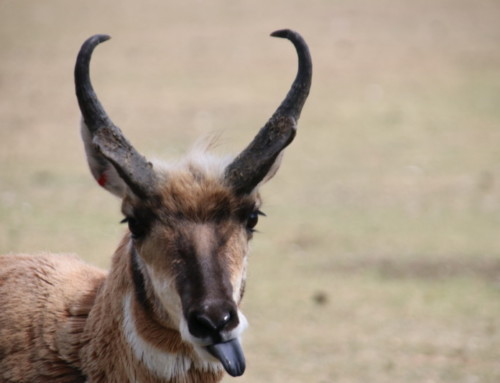The pronghorn gets its name from the conspicuous prong that sticks forward off its shiny black horn. The pre-ice age Antilocaprids (pronghorn) were once a diverse group of 15 to 40 species only found in North American. Following the ice age only one species survived: The Pronghorn.
Standing about the size of a small deer, the pronghorn is vulnerable to predators on the open grasslands. The best defense was to run away from danger. For the last 4 million years the Pronghorn (Antilocapra americana) has been the champion runner on the grasslands of Saskatchewan. It has the ability to lope at 50 km/h for three to four hours at a stretch. If the need arises, it can cruise at 70 km/h. The Pronghorn is able to achieve this remarkable level of endurance thanks to some special super-sized features. The windpipe of a Pronghorn is twice as wide as ours. Compared to a goat of similar size its lungs are three times larger. All that oxygen is absorbed by a larger blood volume and pumped by a larger heart. The result: a pronghorn can process 5 times more oxygen than a typical mammal, and three times more than a human runner. A larger heart and lungs means its stomach is smaller. And all runners know how hard it is to run with a full stomach. A pronghorn has a lightweight design as well. The lower legs seem impossibly thin and delicate, and its hoof has been reduced to only two toes from four. (Pronghorn are missing the lateral toe toes or dew-hooves found on other hoofed animals like deer). Instead of heavy antlers or permanent horns, the pronghorn is equipped with lightweight horns. Every fall, after the rut, they shed the outer sheath of their horn.
Endurance is one thing, but the pronghorn also has speed. Up until 10,000 years ago Saskatchewan’s grasslands were home to Lions (Panthera leo…yes, the same species that live in Africa and India today), and not one, but two, species of Cheetah: The America Cheetah (Acinonyx tumani) and the Studer Cheetah (Acinonyx studeri). It was the cheetahs with their impressive speed that were the most specialized to chase and kill pronghorns. Cheetahs are the fastest mammal on the planet, attaining speeds up to 100 km/h. However, the pronghorn is the second fastest mammal on the planet. And thanks to some special features the pronghorn is capable of outrunning a cheetah. The pronghorn is equipped with super-sized eyes which it uses to detect danger well in advance of other prey on the grasslands. Early detection is the key to survival. While a cheetah can attain speeds of 100 km/h the cheetah must stop running after 400m to prevent its body from lethally overheating. A pronghorn can attain speeds of 90 km/h, and it can sprint at that speed for several minutes. This gives the pronghorn the advantage in this chase. It is no wonder the early settlers mistook the pronghorn for an antelope (a mistake that often continues to present day). Pronghorn are not closely related to the antelope of Africa and Asia. They are more closely related to pigs.
Fortunately for the pronghorn the speedy predators like the hyena, lion, and cheetahs disappeared from Saskatchewan’s grasslands by 10,000 years ago as part of the great wave of extinctions. For thousands of years the only predators the pronghorn faced on Saskatchewan’s grasslands were Grizzly Bears and Grey Wolves. Without the speedy predators pronghorn numbers flourished. Pronghorn numbers equaled that of the bison in Saskatchewan, estimated in the millions. However, the arrival of settlers with fences, roads, railways, and over-hunting took their toll. By 1915, there were only 500 pronghorn left in Saskatchewan. To prevent the impending extinction of the pronghorn, the federal government established Menissawok National Park in southern Saskatchewan. The park was successful in bolstering pronghorn numbers and in the 1940s the park was closed. Habitat loss still plays a major role in pronghorn survival. Pronghorn migrate from their summer ranges to wintering areas. Migrating across highways, around settlements and energy developments, and under (pronghorn don’t jump) the fences that crisscross the prairie landscape is a massive challenge. We hope that in the near future Saskatchewan’s government will look into creating safe migration corridors for the pronghorn.

